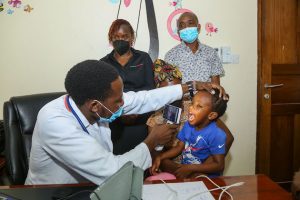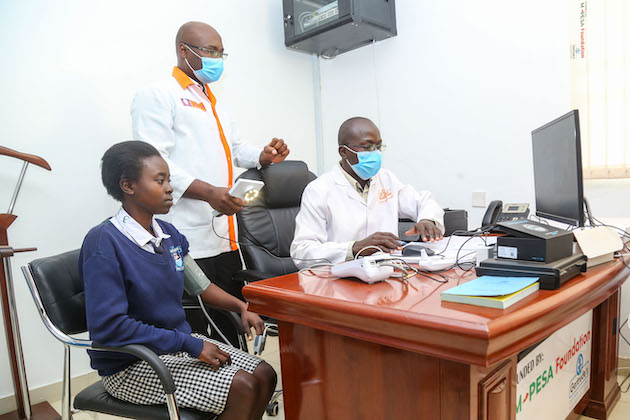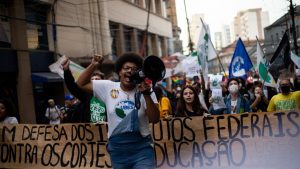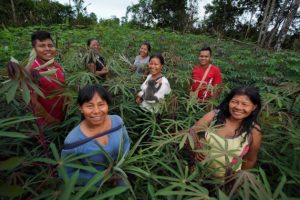
A child has her teeth examined remotely. The Daktari Smart technology means children in rural Kenya are linked to specialist care in big centres. Credit: Daktari Smart
By Wilson Odhiambo
Nairobi, Aug 8 2022 – New telemedicine technology, Daktari Smart, aims to mitigate the gap between child patients and medical specialists in rural Kenya.
Officially launched in November 2021, the system was built to help sick children have easy access to medical specialists minus the cost of being physically present (remote/digital access). According to them, this will help optimise the delivery of healthcare systems.
Kenya Medical Practitioners and Dentist Board estimate that the current patient-to-doctor ratio is 6,355 to 1. These statistics highlight the difficulty that patients have in accessing qualified medical personnel and specialists. Patients from rural and marginalised areas are especially disadvantaged, with some dealing with a total lack of adequate facilities. Others are left to contend with referrals that see them delay treatment.
Daktari Smart thus comes in as the “haven” that these patients had been waiting for, targeting over 32,000 children in Homabay, Samburu, Baringo and Lamu counties in its first phase of operation.
“Daktari Smart is a telemedicine device that offers connections between different counties or locations and the provider of the services,” says Olivia Achieng, program coordinator at Gertrude’s Hospital Foundation.
“This telemedicine system involves electronic medical devices connected to form a platform that enables the clinical workers at the different counties to interact directly with the specialists and sub-specialists in Gertrude’s Children’s Hospital.”
Like many developing countries, Kenya is characterised by limited health facilities in rural areas. Most health specialists and special care facilities are located in the city, mainly Nairobi. Kenyatta National Hospital, Nairobi hospital, and Aga Khan Hospital are among the largest and most reputable hospitals in Nairobi, Kenya, but are over 400 kilometres from Lamu, Homabay, and Samburu counties.
Specialists include paediatricians, surgeons, psychiatrists, and neurologists – the list is long.
“The poor doctor-to-patient ratio makes it hard to get specialists in far-flung areas, making it hard for these patients to get the quality care they deserve. To get the specialist care they need, they will need to travel to cities like Nairobi, Kisumu, Eldoret or Nakuru, which is expensive and time-consuming. This is the gap that Daktari Smart is trying to bridge,” Achieng explained.
Rather than send the patient to a different facility or hospital, the referral process will now be able to be done within the same facility. The patient will be booked and referred over the telemedicine platform.
According to Achieng, the system comprises several electronic devices such as a stethoscope, vital sign monitor, derma scope, electrocardiogram, and ultrasound machine, among many other medical devices assembled to form the telemedicine platform.

Children in rural Kenya can now benefit from a full health assessment without travelling for miles to urban centres. Credit: Daktari Smart
All these devices are attached to a monitor, which allows the specialist to see the patient’s information in real-time. This means that the specialist doesn’t have to rely on second-hand information or someone else’s interpretation of the patient’s condition because they can see everything as it is transmitted first-hand.
Anyango said that once the specialist in Nairobi is done attending to the children he is with, he can then go to the telemedicine room and see whether he has any bookings from Lamu, Samburu, Homabay or Baringo county.
“It is also important to note that this is a paediatric referral platform which means that before a child is referred, he or she has to be properly assessed by the health worker to determine whether or not the case requires a specialist’s attention,” she said.
The M-PESA Foundation invested over Ksh 168 million (about 1.4 million US dollars) in the project, with the expectation of bringing on board two more needy counties and ensuring they can help as many patients as possible.
“One of our main pillars under M-PESA Foundation is healthcare. For this particular telemedicine program, we have partnered with Gertrude’s Hospital Foundation, Gertrude’s Hospital and Safaricom PLC,” said Karen Basiye, Director, Sustainable Business, Social Impact and M-PESA Foundation.
“Our aim is to address the delays in receiving adequate healthcare in rural and underserved areas through telemedicine, starting with Samburu, Homabay, Baringo and Lamu Counties. Two other counties will be brought on board in the next phase of this program,” Basiye told IPS.
“Patients, who have children aged up to 21 years, who would otherwise have to spend a significant amount of time and money on travelling long distances to urban areas to seek care, will now be able to receive specialist care from their local health facility. As a foundation, we are the program’s main funder, investing over Ksh 168 million towards the initiative over the next three years,” added Basiye.
Basiye said that the bandwidth requirement for the system is low, ranging from 512kps to 2Mbps, which makes it suitable for use in rural areas with poor internet connectivity.
“The mission and vision for Gertrude’s Hospital Foundation are to ensure the poor and the needy in the community are taken care of. We noted that the hard-to-reach areas in Kenya are underserved in terms of medical specialists, and this project thus enables us to offer the health part, while M-PESA Foundation helps with the financial side,” Anyango continued.
Dr Alex Owino, Medical Superintendent, Katulani Sub- County hospital, Kitui, agrees that Daktari smart is a great initiative given the few specialist doctors who handle delicate and complex medical cases.
“Most of these specialist doctors are found in major towns, which makes access to specialist care by patients from rural areas very difficult as they have to use a lot of resources just to get to them,” Owino told IPS. “The whole of Kitui county, for instance, has only three paediatricians serving it, which means that general practitioners like ourselves will have to cover the gaps”.
“Having specialists use technology to provide care for patients in hard-to-reach areas will thus lead to better health outcomes as it cuts the need for movement for patients who need help and health workers who may need training,” Owino said.
Owino explained technology is quickly revolutionising medicine with various gadgets and applications being introduced to help improve areas of weakness that have mainly been witnessed in developing countries.
“This technology will not only help the patients but also be very useful in helping improve the knowledge and skills for the health workers in those areas,” Owino concluded.
IPS UN Bureau Report






